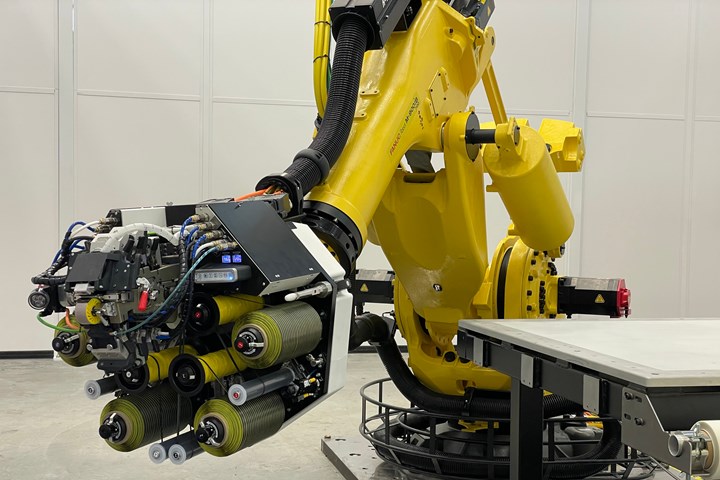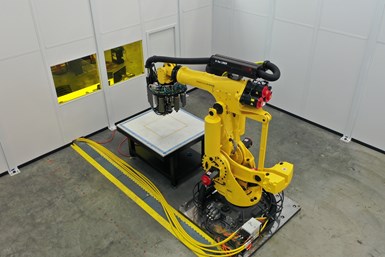Electroimpact launches plug-and-play AFP system
Automation and automated fiber and tape placement specialist Electroimpact has introduced Scorpion, a new modular plug-and-play automated fiber placement (AFP) system designed for research and laboratory applications.

Electroimpact Scorpion automated fiber placement system. Photo Credit: Electroimpact
Automation and automated fiber and tape placement specialist Electroimpact (Mukilteo, Wash., U.S.) has introduced Scorpion, a new modular plug-and-play automated fiber placement (AFP) system designed for research and laboratory applications. Electroimpact calls Scorpion an AFP4.0 system that includes a Fanuc M-900iB/700 robot, a four-lane 0.25-inch AFP head, a 3 x 1.5-meter flat vacuum charge table, a laser safety enclosure and operator interface.

Electroimpact Scorpion automated fiber placement system inside enclosure with vacuum table.
Photo Credit: Electroimpact
The AFP head , which can lay down thermoset or thermoplastic prepreg fiber or dry fiber, features servo-powered creels and offers a two-segment eye-safe laser or a four-segment high-output laser. Speed capabilities include 100 m/min initial feed, 75 m/min refeed and 75 m/min cut. Standard in-process inspection covers tow ends and process errors; optional inspection technologies cover laps/gaps, foreign object debris (FOD) and backer detection. System expansion options include a part rotator, eight- or 16-lane head and 0.125- or 0.5-inch tows.
Related Content
-
Manufacturing the MFFD thermoplastic composite fuselage
Demonstrator’s upper, lower shells and assembly prove materials and new processes for lighter, cheaper and more sustainable high-rate future aircraft.
-
Carbon fiber, bionic design achieve peak performance in race-ready production vehicle
Porsche worked with Action Composites to design and manufacture an innovative carbon fiber safety cage option to lightweight one of its series race vehicles, built in a one-shot compression molding process.
-
The potential for thermoplastic composite nacelles
Collins Aerospace draws on global team, decades of experience to demonstrate large, curved AFP and welded structures for the next generation of aircraft.













